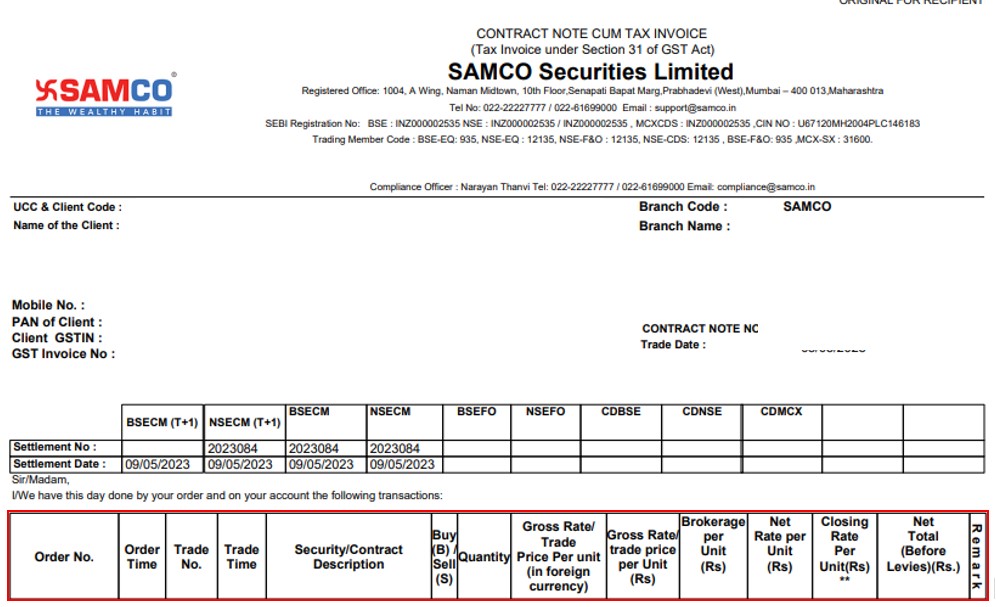A contract note, which describes the specifics of a transaction done by investor/trader, is essentially a legally binding document. It gives a brief overview of the executed trades, including their date, time, and price. It also contains crucial details like the number of shares purchased or sold, the brokerage costs, taxes, and other expenses incurred.
The contract note is more than simply a piece of paper for traders and investors. It showcases their involvement in the market and promotes accountability and transparency. The document serves as ownership proof and can help in settling any potential legal issues in the future.
Why is a Contract Note important for you?
- A contract note is a detail report of all the trades and transactions undertaken in the day
- Contract note makes the trading experience transparent by giving the clients a point of reference to cross-check their trades and transactions.
- Should you be wondering why you have received a (marginally) lower amount than the price you sold your stocks at, or why you are being asked to pay a higher amount for your purchase than the trading price of the stock, you will find the details of this on the Contract note.
- All the brokerage charges and taxes deducted can be found in one place.
- Contract note serves as a legal document in case of any dispute due to non-delivery of stocks.
- While calculating capital gains, users can refer to contract notes to know the exact amount received.
Now, lets understand how to read contract note.
How to read contract note?

- The Order No column displays the exchange order number. This order number acts as a unique identifier for each exchange order entered into the system, so that each order can be easily tracked and managed. This order number is assigned by the exchange.
- Order time displays the timestamp of when the order was placed, this is helpful for tracking and managing the exchange order, as it can be easily referenced and associated with the appropriate order details. 2. This timestamp allows for users to easily view when a specific order was placed, so they can determine how long it has been in the system and when it is likely to be fulfilled.
- Trade No displays the trade number on the exchange. This can be useful if a client needs to review the details of a transaction. Knowing the trade number can also help a user verify the authenticity of the order or transaction.
- The trade time shows the timing of the order’s successful exchange execution.
- The column labeled Security/Contract description presents the stock or instrument associated with the order. The column typically shows the stock symbol, option symbol, or other instrument that the order was for. This allows the user to quickly determine which order was executed and for what instrument.
- The ‘Buy/Sell’ column then provides additional clarification for the type of transaction done.
- Gross Rate/Trade Price Per unit displays the price at which the order got executed.
- The Net Rate per unit (Rs) column will be the same as the gross rate per unit, as brokerage charges are mentioned separately in the contract notes.
- The Closing Rate per unit (only for Derivatives) (Rs) pertains to derivative contracts that are carried over and indicates the price at which the contract was closed for the day.
- The Net total (Before Levies) represents the total amount owed to or by the client before accounting for brokerage fees and taxes.
The last page displays:
• All relevant brokerages and taxes, including exchange transaction tax, GST, STT, stamp duty, and SEBI turnover charge. If the billing address is in Maharashtra, CGST and SGST of 9% each, and IGST of 18% for other states, would be charged.
• At the bottom of the table, it will mention the net amount due or payable.

Things you must know?
- The contract note does not include additional charges such as call and trade fees and DP charges.
- Scrip-wise charges are not listed on the contract note.
- Annual Maintenance Charges (AMC), payment gateway charges, and delayed payment charges are also not displayed on the contract note.
In conclusion, a contract note is an essential component of the stock market ecosystem since it gives traders and investors a detailed record of their activities. By understanding their own components and significance, you can enhance your trading/investment decision-making process and maintain a systematic approach to your trading activities.


 Easy & quick
Easy & quick
Leave A Comment?